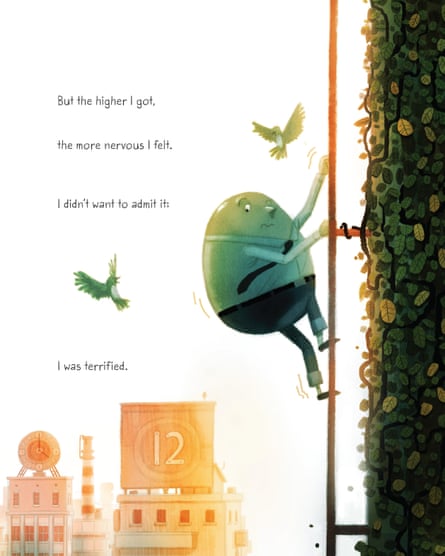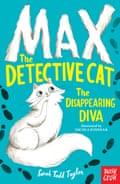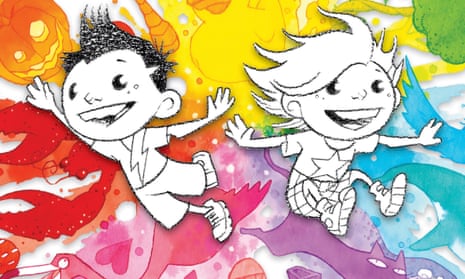Unusual titles for eight to 12 are blooming this spring, including Julie Hunt and Dale Newman’s KidGlovz (Allen & Unwin), an Australian graphic novel in the vein of Brian Selznick’s The Invention of Hugo Cabret. KidGlovz is a child prodigy, starved by his showman “uncle” to keep him small. After he is kidnapped and his hand injured, he is abandoned as useless. Can KidGlovz and his friend, the thief Shoestring, survive alone in the wintry mountains – and has Kid lost his heart’s music along with his fingers? Though less nuanced than Selznick’s work, this meandering adventure, with its thought-bubbled, pencil-shaded illustrations, has memorable charm.
There is more unconventional storytelling in Kwame Alexander’s verse novel Rebound (Andersen), a prequel to his Newbery-winning The Crossover, which features comic strip daydreams as well as poetry. Chronicling 12-year-old Charlie Bell’s grief at the loss of his father, his banishment to his grandparents’ house and his developing love of basketball, Alexander effortlessly marries rap rhythms with plaintive, passionate and deceptively simple verse.
More straightforwardly told, though just as moving, is Boy 87 (Pushkin) by Ele Fountain. This is the story of Shif, a clever, competitive 14-year-old who finds himself summarily imprisoned in a desert camp by the military “giffa”. After losing his dear friend in an attempt to cross the border, he must adapt to hostile new surroundings, and he faces a dangerous, desperate journey to find refuge. Full of tension, fear, heartbreak and hope, it conveys both the bitterness of having family, home and identity stolen away piecemeal, and a courageous determination to survive.

For teenagers, Elizabeth Acevedo’s debut The Poet X (Electric Monkey) delivers powerful, finely crafted verse, each poem-chapter blending elegantly with the next. Xiomara, daughter of Dominican parents living in Harlem, is allowed almost no freedom by her devout mother, though she still attracts the attention – often unwanted, occasionally exciting – of men. The most important thing about Xiomara, though, is her unique voice, which she sets free in her poetry. Readers will yearn to finish this verse novel in a single sitting, but its echoes will remain with them much longer.
A distinctive voice also narrates The Territory – Truth (Firefly), the culmination of Sarah Govett’s gripping trilogy set in a climate-changed Britain in which only teenagers who pass a rigorous exam earn a place in the safety of the Territory. Noa and her exiled crew have information that could undermine the authorities – but can they break through the gun-turreted electric fence? Dystopian YA is frequently cliche-prone, but Govett’s humorous, unflinching handling of plot and character, particularly her irrepressible protagonist, makes this feel vivid and fresh; the scene in which the rebels force themselves to torture a Territory employee is particularly thought-provoking.
A blingy gold cover draws the eye to Juno Dawson’s Clean (Quercus), the foul-mouthed, in-yer-face account of Lexi, a super-rich party girl gone off the rails, and her effortful journey towards kicking her heroin habit. Set in a plush rehab facility, Dawson’s latest novel mingles pitch-perfect pop-culture references with the layers of lies and self-justification in which the addict’s mind wreathes itself; it’s compulsively readable, hilarious and filled with uncomfortable truths.

For those who like Chosen One fantasy with a difference, Nnedi Okorafor’s sequel to What Sunny Saw in the Flames, Sunny and the Mysteries of Osisi (Cassava Republic), features Sunny Nwazue, a black albino girl born in New York, and a new member of the magical secret society the Leopard People. Now living in Nigeria, Sunny must balance the demands of school and family with the Leopard People’s strict rules, while learning to read the magical Nsibidi script and attempting to vanquish the wicked spirit Ekwensu once and for all. Okorafor’s storytelling is detailed and absorbing, full of monsters and big consequences for losing control.
There’s a treat in store for five- to eight-year-old readers from Katherine Woodfine, author of The Sinclair’s Mysteries: a brief, highly readable story about the inventor of haute couture, Rose Bertin, Rose’s Dress of Dreams (Barrington Stoke). Illustrated by Kate Pankhurst of Fantastically Great Women fame, this pink-clad paean to design and dressmaking as artistic rebellion is the perfect book for any child for whom devising costumes is the deepest form of thought and creativity.
Several collections of kid-friendly experiments have been published recently, but Mr Shaha’s Recipes for Wonder (Scribe) knocks most into a cocked hat. From a catapult constructed from a Pringles tube to the chemistry of a microwave cupcake, Alom Shaha first dangles an enticing activity, then meticulously – and thrillingly – details the scientific principles behind its operation. Emily Robertson’s glorious illustrations add to the book’s bursting, irresistible sense of excitement.
Children with a yen for animal investigations, and stamina enough for a slightly longer read, will delight in Sarah Todd Taylor’s Max the Detective Cat: The Disappearing Diva (Nosy Crow). Pampered puss Maximilian didn’t plan on becoming head mouser at the Theatre Royal – but soon discovers a flair for theatre life and nosing out why famous diva Madame Emerald is behaving so oddly. Full of humour, period detail and deft characterisation, the story is given still more charm by Nicola Kinnear’s expressive illustrations.

In picture books, Caldecott-winner Dan Santat revisits Humpty Dumpty in After the Fall (Andersen), a tender, wryly funny look at trauma and recovery from the perspective of the world’s most famous egg. Humpty is afraid of heights – what will it take to spur him to the top of the wall again? Santat’s new conclusion is both logical and breathtaking.
From Elephantom author Ross Collins, Colour My Days (Barrington Stoke) looks at first like a colouring book awaiting the crayon; turn the pages, however, to see Emmy and Jeff and their surroundings brought to life by a succession of colours. Each hue boasts its own distinct character, and the story is saturated with gentle, involving wit.
Finally, Morag Hood addresses the question “what’s in a name?” in the superlative comedy The Steves (Two Hoots), a brightly coloured battle between two puffins with the same name who sling outrageous insults in their quest to determine who the best Steve really is. Watch out for a warm eventual reconciliation – and a final sting in the tail.

Comments (…)
Sign in or create your Guardian account to join the discussion